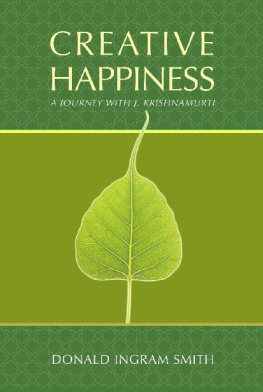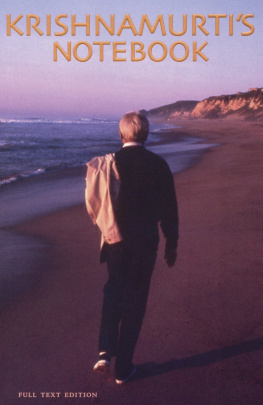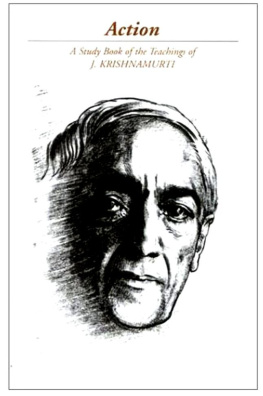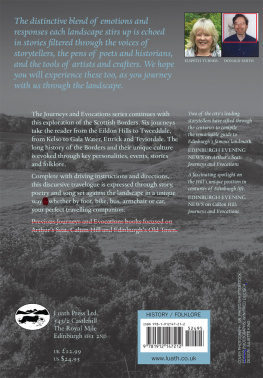Donald Ingram Smith - Creative Happiness: A Journey with J. Krishnamurti
Here you can read online Donald Ingram Smith - Creative Happiness: A Journey with J. Krishnamurti full text of the book (entire story) in english for free. Download pdf and epub, get meaning, cover and reviews about this ebook. year: 2013, publisher: Karina Library Press, genre: Detective and thriller. Description of the work, (preface) as well as reviews are available. Best literature library LitArk.com created for fans of good reading and offers a wide selection of genres:
Romance novel
Science fiction
Adventure
Detective
Science
History
Home and family
Prose
Art
Politics
Computer
Non-fiction
Religion
Business
Children
Humor
Choose a favorite category and find really read worthwhile books. Enjoy immersion in the world of imagination, feel the emotions of the characters or learn something new for yourself, make an fascinating discovery.
- Book:Creative Happiness: A Journey with J. Krishnamurti
- Author:
- Publisher:Karina Library Press
- Genre:
- Year:2013
- Rating:5 / 5
- Favourites:Add to favourites
- Your mark:
- 100
- 1
- 2
- 3
- 4
- 5
Creative Happiness: A Journey with J. Krishnamurti: summary, description and annotation
We offer to read an annotation, description, summary or preface (depends on what the author of the book "Creative Happiness: A Journey with J. Krishnamurti" wrote himself). If you haven't found the necessary information about the book — write in the comments, we will try to find it.
Creative Happiness: A Journey with J. Krishnamurti — read online for free the complete book (whole text) full work
Below is the text of the book, divided by pages. System saving the place of the last page read, allows you to conveniently read the book "Creative Happiness: A Journey with J. Krishnamurti" online for free, without having to search again every time where you left off. Put a bookmark, and you can go to the page where you finished reading at any time.
Font size:
Interval:
Bookmark:
Table of Contents
Creative Happiness
A Journey with J. Krishnamurti

Karina Library Press
2013
Creative Happiness: A Journey with J. Krishnamurti
ISBN: 978-1-937902-21-6
Library of Congress LCCN: 2013949624
Karina Library Press
PO Box 35
Ojai, California 93024
www.karinalibrary.com
Happiness is a state of being alive, awake in truth. The very essence of everything is happiness, an ever alive activity. It is immediate, spontaneous, the very stuff of life: it is the essence of being. Happiness is creativity, the creator, and the creation.
from the last words of Donald Ingram Smith
INGRAM SMITH
Donald Ingram Smith (1912 - 2006) was a radio broadcaster for the Australian Broadcasting Corporation (ABC) who first met Krishnamurti when he was assigned to produce a broadcast for Krishnamurti in 1949 in Colombo, Sri Lanka. This began a lifelong association with Krishnamurti.

FOREWORD TO THE NEW EDITION
The first edition of Donald Ingram Smiths memoirs was entitled Truth Is a Pathless Land (Quest Books). The second edition was entitled The Transparent Mind (Edwin House) and included for the first time journal-like reflections on Ingram Smiths own obsevations after Krishnamurtis death in 1986. This third edition, Creative Happiness , from Karina Library Press is a revised, re-designed book of the text from the Edwin House edition.
FROM THE AUTHORS PREFACE,1999
The sojourn with Krishnamurti has gone on evolving, deepening, revealing that Truth is not a continuum but an ever-changing, always present reality, ever creating new meanings. Earlier perceptions have revolutionized, and opened a number of unexpected dimensions.
Awareness of the falseness in ones thinking and behavior reveals the need to stop, look, and listen. Perhaps in the pause, in the stillness, the clarity to see what is permits Life to make the needed change.
Given no energy, the false fades. The mind is transparent, a portion of the self is gone, allowing a new freedom and a new reality, a wholeness, to come into being.
UNCONDITIONALLY FREE
J. Krishnamurti (18951986) at the outset of his lifes work in 1929, said that his only concern was to set men and women absolutely, unconditionally free. Until his death, he traveled throughout the world speaking to audiences on every continent. In support of his work, five foundations were established to coordinate the activities that grew out of his talks.
In his talks, Krishnamurti asked for a particular kind of participation on the part of the audience. He was not giving a predetermined lecture to which the audience listened with agreement or disagreement; he was not presenting a point of view, doing propaganda for an idea, belief or dogma, or leading the audience to a particular conclusion. Instead, the speaker and listeners were together exploring human problems. This is an art that is learned in the very act of attending to what Krishnamurti is saying. This attention is not an effort of concentration; it comes naturally when one is deeply concerned with the many problems of existence.
It is central to Krishnamurtis teaching that for us to be truly free, we must first be aware of the psychological conditioning that prevents us from seeing things as they really are. This quality of attention to what is not to what one likes or dislikes, nor to what some authority says is so, but to the actual thing itselfis at the very core of his work. In this attention, the mind stops chattering and is still. There is only what is , and in this, there is the quality of love, of beauty, of order.
Krishnamurti was born on May 12, 1895, in a small town in South India east of Madras. As the eighth child of a Brahmin family, and a boy, he was by tradition called Krishnamurti in honor of Shri Krishna, a Hindu divinity born an eighth child. While living at Adyar, the international headquarters of the Theosophical Society, he was discovered by C.W. Leadbeater, an eminent Theosophist. There its president, Annie Besant, along with Leadbeater, trained him for his future role as a Teacher known throughout the world. In 1911, the almost sixteen-year-old Krishnamurti, with his younger brother, was brought to England, where he was privately educated. He began to speak along lines that broke with all tradition in 1929, when he repudiated all connections with organized religions and ideology. From then on, Krishnamurti traveled the world, writing, speaking, and discussing.
Many years ago he said,
So, if you want to spread these teachings, live them, and by your life you will be spreading them, you will be communicating them, which is more true and significant than verbal repetition, for repetition is imitation and imitation is not creativeness. You as an individual must awake to your own conditioning and thereby free yourself and hence give love to another.
A PARABLE
A man who lived in a small village found his hands were manacled. How he came to be handcuffed is of no importance. It may have been a policeman, his wife, the mores of society, his religion or his education; more likely he had unwittingly locked the bracelets on himself. What is important is that he suddenly realized he could not use his hands freely, that he was constricted.
For some time he wrestled with the cuffs and their interlocking chain, hoping to break free. He tried to force the encircling steel rings over his hands. He merely tore the skin, lacerated the flesh. Defeated and anxious, he went out into the streets seeking someone who could release him. Though most offered advice and a few actually tried to free his hands, their efforts always resulted in further bruising, aggravating the pain, the disappointment and distress. Soon his wrists became so sore he was afraid to ask for help yet he knew he could not tolerate the constant hurtand the bondage.
Desperate, he wandered the streets until, while passing a noisy blacksmiths forge, he noticed the smithy beating a bar of red-hot iron into shape. He paused by the door watching. Maybe this man could
When the smithy finished the job, he looked up, and seeing the manacles said, Come in, my friend. I can free you. And at his instruction, the distressed man placed a hand on either side of the anvil, exposing the chain.
One blow and the chain snapped, two more blows and the manacles fell apart. His hands were released, and he was free to walk out into the sun and the open sky, free to do all those things he wanted to do.
It may seem strange that he decided to stay in the blacksmiths forge, in the grime and the noise. Yet he did. He felt beholden to his liberator. He had a deep feeling of reverence for, and a wanting to serve the man who had so easily released him. He thought it his mission to stay there and work. He did, and he made a poor assistant.
Free of one set of chains, he accepted another more profound, longer-lasting bondage, a manacle of the mind. Yet, he had come seeking freedom.
A PERSONAL NOTE
In 1947, eight people interested in Krishnamurti began meeting regularly at my parents home in Newport Beach, Sydney, Australia, where we read passages from his books and discussed the teachings. They were all-day meetings, on the first Sunday of the month. We all brought our own lunch; tea and fruit juices were provided. The intensity and seriousness grew, as did the numbers (to thirty, and sometimes more).
Early in 1949 came the news that Krishnamurti was to give talks in Colombo, Sri Lanka, in December of that year, and I decided to be there. At that time, I was a freelance writer/producer of radio programs for the Australian Broadcasting Commission.
Next pageFont size:
Interval:
Bookmark:
Similar books «Creative Happiness: A Journey with J. Krishnamurti»
Look at similar books to Creative Happiness: A Journey with J. Krishnamurti. We have selected literature similar in name and meaning in the hope of providing readers with more options to find new, interesting, not yet read works.
Discussion, reviews of the book Creative Happiness: A Journey with J. Krishnamurti and just readers' own opinions. Leave your comments, write what you think about the work, its meaning or the main characters. Specify what exactly you liked and what you didn't like, and why you think so.





